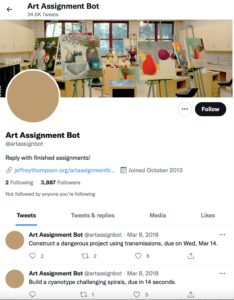Art Assign Bot&Learning theories

SOCIAL CONSTRUCTIVISM
The social constructivist view of knowledge: the dynamic nature of knowledge (knowledge at this stage is not static)
The social constructivist view of learning: 1. active construction :The view that learning is a process of active construction, no matter how well the teacher speaks and visualizes, students cannot learn exactly as the teacher thinks, they need to take the initiative to construct
2. Social interaction :Learning has teacher-student interaction and student-student interaction, and the learning process should strengthen the interaction, and students should be allowed to see different views from their own
3. Contextuality: Students must enter a context in order to learn faster.
The social constructivist view of the student: students do not enter the classroom with an empty mind, they receive knowledge based on their existing life experiences.
The social constructivist view of the teacher: the teacher is a helper, a collaborator, a teacher and student working together, and the teacher guides students to grow new knowledge experiences from their existing knowledge structures through help and support
The constructivist view of knowledge tells us that knowledge is not an absolute truth.
Teaching must not ignore students’ experiences, but use them as a point of growth for new knowledge, guiding students to grow new knowledge experiences from their previous ones. Teaching is not the transfer of knowledge, but the processing and transformation of knowledge. Teaching should enhance cooperation with students be socially interactive so that they can see perspectives different from theirs and thus facilitate learning.
The Art assignment robot can then be analysed in terms of constructivism. Firstly, all tasks issued by the robot need to be actively constructed by the participants, which is an active learning process. Secondly, in the process of completing the assignment, students can leave comments and upload their ideas to Twitter, which allows them all to see different ideas from their own. On the third point, the assignment bot sets up scenarios when posting art tasks. For example, “Build a flipbook about burglaries, due on Wed, Mar 14”, students will complete this task in a contextual way and will create something based on their existing life experiences.
What is lacking in this practice of Art assignment robot is the position of the teacher. I think the absence of the teacher can be explained by the introduction of connectivism
CONNECTIVISM
Connectivism sees learning as a creative process.students learned through informal network technology enabled environments. They connect information because they have a desire to know more, and they have the decision making skills about learning what deciding for themselves what they need to learn.Learning and knowledge rests in diversity of opinions.
From a Connectivist perspective, art-learning projects such as @artassignbot could be seen as Learning Management Systems (LMS) that share an ability to connect large numbers of participants (‘massive’) through establishing common learning endeavors.
The assignment robot is certainly a practitioner of connectionism and is able to connect a large number of participants for feedback. In this process there is also no more teacher or student. This artistic practice serves to encourage audience participation, can motivate audiences and also has the potential to achieve good results as audiences are able to create an artistic project themselves based on instructions.
In a way, the absence of the teacher can be seen as an advance in education, as connectionism emphasises, eliminating the presence of the teacher and making each one a learner. However, it is worth noting that the absence of teachers does not mean that knowledge can be accessed equally. The very existence of information technology creates a monopoly of information, and while connectionism seeks to dissolve the authority of the teacher, the domination of information in the Internet age becomes the establishment of a new authority
Art Assignment
I think of art assignment as a form of art education, and there is no doubt that it has enriched art education. I think it enhances education to a certain extent by making it more interesting, communicative and also by giving full play to human initiative and motivation. However, it lacks a system of evaluation, which I cannot ignore. Both artworks and art practices, including art education itself, need to have their corresponding evaluation systems, otherwise how can we judge the merits of education?
Or perhaps it is possible to see Art asssignment as a universal approach to art education, simply to attract more people (especially those who are not involved in the arts and have not received professional art training) to art practice. But what we need to explore is the implications of this; can everyone be educated in the arts?Does art have its specific audience? If some people are unable to create art, can they be educated in the arts?




A very good article. By examining three TOPICS, it leads from social constructivism to connectivism and compares them to Art assignment and gives its own viewpoint. Made my reading particularly logical and understood your thinking very clearly. I believe that in education, the teacher, the student and self-learning are all indispensable and that the relationship between these three is even more worth rethinking to construct a new balance in future educational inquiry.